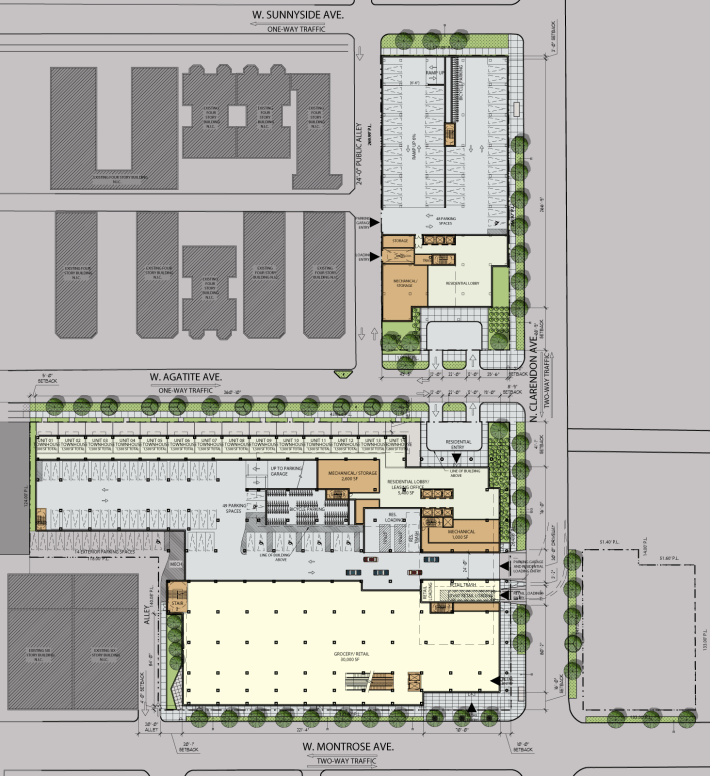
At the site of the former Cuneo Hospital and Maryville Academy in Uptown, slated to be demolished shortly, JDL Development has proposed building 749 apartments in two buildings, along with 30,000 square feet of retail space. In addition, 554 parking spaces will be constructed, the minimum required by Chicago’s zoning code.
Of these spaces, 65 will be set aside for the retail (likely a grocery store), while the remaining will be for residents. The parking will be "unbundled" from the price of housing, meaning that tenants will not have to pay for parking if they don’t need it. The spaces for retail will be offered free of charge to patrons.
Chicago shouldn’t require so much parking. The developer, James Letchinger, said in an email that 60-65 percent of parking in JDL's other developments sit empty. At tens of thousands of dollars per space in construction costs alone, all these parking spaces drive up the price of housing and the cost of retail goods. Parking mandates also result in less space being developed for more productive uses.
Other large residential buildings nearby provide fewer parking spaces per apartment. 4550 N Clarendon, just three blocks north, has 500 residences and 286 parking spaces – 0.57 spaces per unit. The JDL development would offer 0.65 spaces per unit. 4550 N Clarendon has a lower parking ratio because 395 units are low-income units, which have lower minimum parking mandates in the zoning code. Both 4550 N Clarendon and the proposed development are adjacent to two express bus routes (#135 and #148) to the Loop, the #78 bus running west along Montrose, and just over half a mile from the Wilson Red Line station.
However, JDL can't build a lower ratio of parking spaces, and they would have to build an even higher ratio if the parcel wasn't on track to get upzoned.
A common complaint from opponents of new developments is that the added density will generate more traffic. In the current system, which requires a set number of parking spots, this concern makes some sense. But it doesn't make sense if the capacity for parking is reduced and residents use other means to get around. Half of all Uptown residents commute mainly by transit, and 45 percent do not own any cars.
More efficient parking and promotion of alternatives to driving or car ownership altogether are in line with the goals of the city and the neighborhood. The Clarendon/Montrose TIF lists “encourage the use of public transit” among its redevelopment objectives [PDF]. The city’s zoning code states that planned developments, of which this is one, should "promote the safe and efficient circulation of pedestrians, cyclists, and motor vehicles," and "promote transit, pedestrian, and bicycle use."
The 46th Ward Master Plan [PDF], updated in June 2013, calls for "programs that promote reducing the dependency on cars,” and the “evaluation of current parking utilization and efficiencies... and identification of under utilized parking areas and garages." An excellent example is the 1,138-space garage at Truman College. Located directly adjacent to the Red Line and just five blocks from JDL's proposed development, this free garage for students generates a lot of daytime traffic when courses are in session, but sits empty overnight and is highly under-utilized on weekends and during the summer.
Identifying these existing under-utilized parking structures and adapting them for use by multiple parties is exactly the kind of innovation we need to make parking more efficient, directly in line with the Ward Master Plan.
The city's planned development ordinance also says developments should "minimize and mitigate traffic congestion associated with the proposed development." But by requiring parking, the city's zoning code exacerbates traffic associated with specific developments.
Just one block from Lake Shore Drive, Montrose at Clarendon already handles over 14,000 vehicles per day. Clarendon is a much less-traveled street, with 4,700 vehicles daily. A walkable street with low traffic, sharrows, and adjacent to two schools, Clarendon won't be as good for walking and biking after the addition of a huge garage. The addition of a parking structure entrance and a loading bay for retail deliveries on Clarendon just a half block north of Montrose will also create more conflict points between drivers and pedestrians.
Chicago needs parking reforms that make it easier for developers to build less parking and to identify existing parking assets in the community. The last time Chicago reformed its parking requirements was 10 years ago. Since then, there have been improvements to public transportation, improvements for bicycling, and the introduction of CDOT’s pedestrians-first complete streets policy. It’s time to take another look at how parking policy works at cross-purposes to the cities transportation goals.




